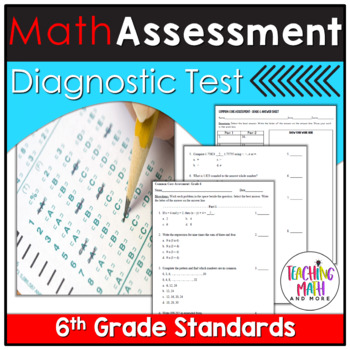Math Diagnostic Assessment Grade 6 | Math Diagnostic Test 6th Grade
- PDF
What educators are saying
Also included in
- Want to know where your students measure with the 6th grade standards? Use these assessments at the beginning, middle, and end of 6th grade math. Easy to grade and keep on record of each student's knowledge of sixth grade skills. Aligned to all 6th grade standards. SAVE 20% OFF all math assessmentsPrice $24.00Original Price $30.00Save $6.00
Description
This Assessment covers 6th Grade Common Core Standards. A great tool to use as a Diagnostic Test, Review, Test Prep, Intervention, or Exam. To gather a more holistic picture of what the student knows, doesn’t know, and help the student fill in the gaps. Part 1 is based on 5th grade Common Core Benchmarks and Part 2 is based on 6th grade Common Core Benchmarks.
SAVE 20% OFF when you buy the Math Assessment Bundle for 6th Grade.
Be sure to check out the preview to see everything that is included!
This Assessment Packet is also available in the following bundle(s):
Back To School NO PREP Math Packet - 6th Grade
Included in this Math Diagnostic Test packet are:
- 2 Parts of Assessment (Part 1: 5th Grade CCSS, Part 2: 6th Grade CCSS)
- 30 Multiple Choice Questions
- Answer Key Included
- Answer Sheet Included for Students to Record On
- Grading Rubric Included
- Covers 5th & 6th Grade Common Core Standards
- Estimated Class time is 1 class period (30-60 minutes)
Need a different test?
Common Core Assessment Diagnostic Test Prep - Grade 7
Common Core Assessment Diagnostic Test Prep - Grade 8
Want the digital version too?
Try the Digital Math Diagnostic Assessment for Grade 6 HERE
Don't forget that leaving feedback earns you points toward FREE TPT purchases. I love that feedback!
Also, follow me and be notified when new products are uploaded. New products are always on sale for the first 24 hours they are posted.
As always, please contact me with any questions!
Thank you,
Kelly McCown



